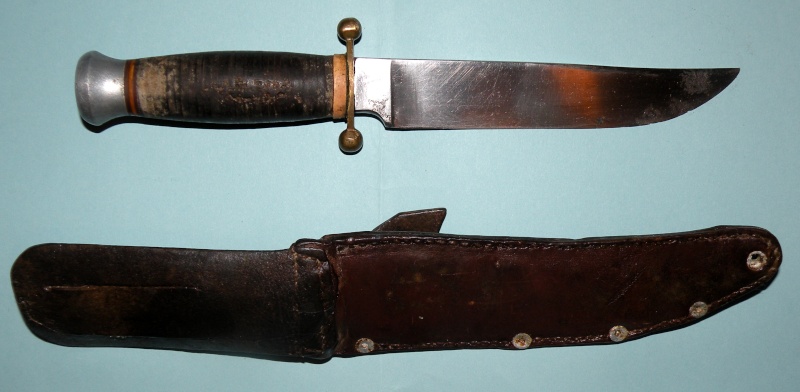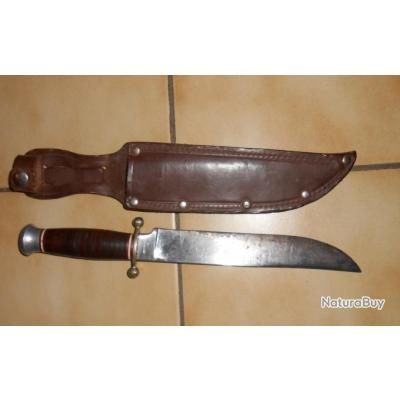- Joined
- May 16, 2010
- Messages
- 9,347
I bet.
Plenty terrifying, yes.
Plenty terrifying, yes.
The BladeForums.com 2024 Traditional Knife is available! Price is $250 ea (shipped within CONUS).
Order here: https://www.bladeforums.com/help/2024-traditional/
Maybe I missed it somewhere. But.....isn't a karambit considered a close contact fighting knife.
Lol..hell, if you weren't warned, outgoing 120mm sounds like the base just took a hit. It's loud. The one time they hung some rounds without me being on the gun (without warning), i hit the ground.
We were trying to nail one of the @#$%ers with both mortars after one attack, and our interpreter was listening to what the tali was saying on the radio to his guys as our rounds fell:
i'm down by the river. They don't know where i am.
I s**t my pants.
Dont believe Fairbairn and Sykes would agreeClose combat knives are safer for the user if there is only one edge and not two. In close combat the knife is kept tucked close to the users arm and not waving around where he can be disarmed.
I trained under an Army Ranger for 5 years and it hurt a lot, but then I learned a lot.
Fred
Dont believe Fairbairn and Sykes would agree
Yeah I know, they were advocates of certain blades for a specific use
The suggestions from Mr. Apelt are almost all correct, except
Which is, of course, ridiculous. Knives are in fact the most dangerous weapons up close. Despite that, a 3-4" sturdy knife is a good choice. This is a Shirley-Owens MK1, which I think is about right for most troops. Most of the Special Ops troops I've been on missions with did not have large knives, even when routinely close to the enemy (speaking of which- not sure how you're going to maintain 100 meter separation from the enemy when kicking in doors. Just sayin'). The single exception was a PRT Marine Gunny Sgt with a huge Pakistani Rambo knife. I asked him about it, and he said he just used it for crowd control. It worked, too- I saw him pull it out and just hold it in front of him. And the Afghan LNs just parted, like Moses parting the seas.

The knives I have actually used in combat were a Spyderco Native LW, serrated, and a custom Shane Justice knife. Both used to get into mortar crates and "tootsie roll" ammo carriers. Here's a pic of me with the SJ Soldier's Knife in early 2007 after a firefight. In case any of you don't know, war always ends up muddy.

(Here's a pic of the Soldier's Knife- which is actually a little larger than most Soldiers need, but which was good to have to get into ammo crates quickly during a firefight.- with other tools for size reference)
So, again, a 3-4" sturdy, single-edged knife is probably the best all-around combat knife. A sturdy, quick-access sheath that can be mounted on armor or belt is needed. Anything larger starts to interfere with other gear, and anything smaller is only useful for slicing and opening packages.
John Shirley


A 3-4" blade is a -moderately- good idea for utility, but for fighting use it is self-defeating, and of not much use as a morale-builder...: Knives are already well known to have very little "stopping power", so a blade this small worsens what is the worst thing about fighting with knives... Without a deep stab, or a deep and broad slash, a failure to stop the opponent is virtually guaranteed: Knives are extremely weak weapons, and making them small worsens this worst aspect of their use as a weapon...
Furthermore, the custom knife shown above has a deep belly, which almost garantees poor performance for fighting: Its design is more that of a skinner.
For real utility I would go for expendable items like box cutters, pliers, screwdrivers, nailclippers, etc...
In Europe, from the 1930s to the 1970s, the name "Boy Scout knife" applied to a specific knife design that had a 7" blade and was built like a true fighting knife: It is the only specific knife design that I know of that is referred to generically as a "Boy Scout Knife" by Europeans of a certain age: This style of knife was often carried in combat by French soldiers in Algeria, among whom my father: They were very finely made, despite production in the millions intended for ten year olds, and the carbon versions were extremely sharp (the stainless ones were hard to get sharp, for some reason):
Blade length was typically 7" on a 4" handle, for 11" overall: Over 3/16" stock at the guard, very strong, with a full distal taper, extremely light as a result (much too light in my opinion):



These knives were then carried with great satisfaction by French soldiers in Algeria, where you never knew when and where the enemy might turn up. You could be his guest and he would treat you well, until the moment you left his home... Quite comparable to Irak, except Algeria was a lot bloodier... You never knew who you were dealing with...
These knives were considered modest enough to be routinely issued to millions of ten year old Boy Scouts... It would be quite amazing historically if the US Army had grown so PC that these Boy Scout knives, intended for ten year old civilians in the millions, would now be forbidden to modern front line soldiers...
As to daggers being dangerous to the user in fighting due to being double-sided, I don't think that's true, but it is true a single edge knife of similar point sharpness is far more useful than any gain from a double edge: The main gain I see with a double edge is that it is typically 25% lighter owing to the grind, and more if the blade is narrow, which still allows great point slicing due to the lack of belly (skinners don't point-slice, they point-push)...
One must be aware that the current fashion for small fixed blades is a very recent one, and has more potential for detriment than usefulness. I would say any military blade under 6" should be a pocket folder.
Gaston
Wow,
As the maker of that knife, the previous post, is basically a slap in the face.
In other times,I would allow you the choice of weapons.
Unfortunately, I am old and sick and crippled. You just keep talking and talking. There is no better way for.you to PROVE your inexperience and ignorance about knives, edge.geometry, grind contours and
Blade engineering.
I don't have the energy to write more. Too bad people are so dumb, it's good I can't. make knives any more. I would.build you all a "skinning knife" that will carve livers and take hair and fingers like you cannot believe!
ShaneJustice
